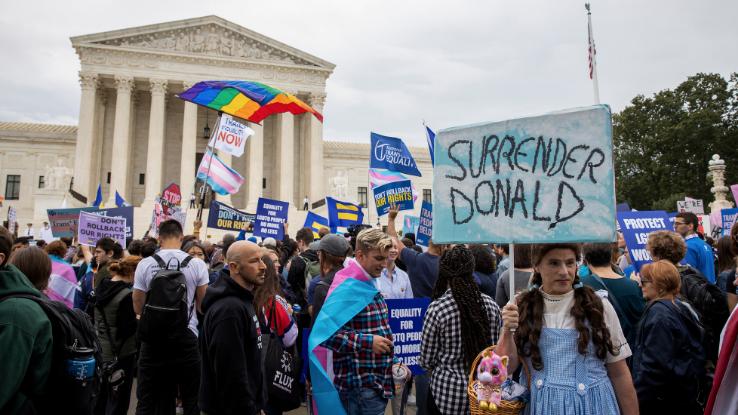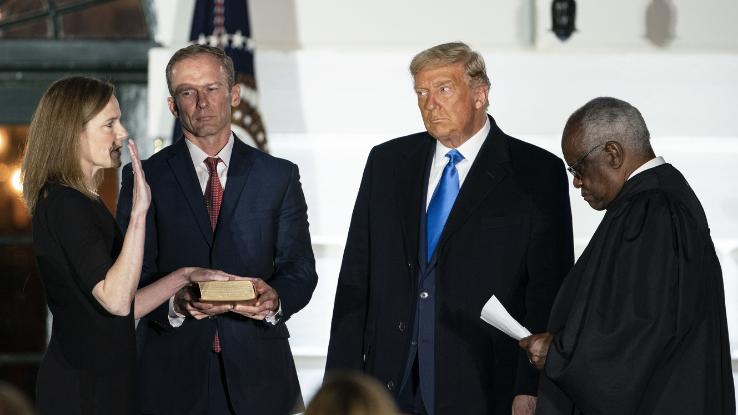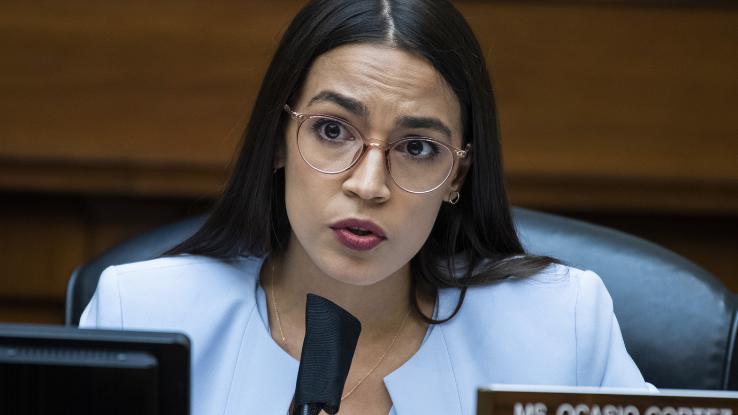Which of These Landmark Cases Determined That the Supreme Court Could Review State Court Decisions?

When Justice Ruth Bader Ginsburg passed away on September 18, 2020, many Americans didn't accept the proper time to grieve — instead, they panicked about what her passing meant for the time to come of the country. Property the rest of an entire democracy is too great a brunt for anyone's shoulders, and Justice Ginsburg had been conveying that weight for a long, long time. Instead of belongings infinite for her passing, Republican politicians wasted no fourth dimension in queuing up a nominee for the empty Supreme Court seat, eventually landing on Amy Coney Barrett — a longtime Notre Dame Law School professor who served fewer than three years on the Seventh Circuit before her nomination to the highest courtroom in the American judicial system.
In 2016, then-Senate Majority Leader Mitch McConnell infamously vowed to block President Obama's outgoing Supreme Court nomination of Merrick Garland on the grounds that the American people should have a "vocalization" and that to rush a nomination (and confirmation) would be to overly politicize the effect. In 2020, however, McConnell didn't hold to those principles he outlined four years earlier, leading to Barrett's confirmation hearings and equally rushed swearing in ceremony, which took place about a calendar week before Election 24-hour interval on October 26, 2020.
This move led many to criticize McConnell, including New York Representative Alexandria Ocasio-Cortez (@AOC), who simply tweeted, "Expand the court." Additionally, Massachusetts Senator Ed Markey (@EdMarkey), who is Ocasio-Cortez's Green New Deal co-author, tweeted, "Mitch McConnell set the precedent. No Supreme Court vacancies filled in an election year. If he violates it, when Democrats control the Senate in the next Congress, we must abolish the filibuster and aggrandize the Supreme Courtroom."
The Number of Supreme Court Seats Has Been Adjusted Earlier — Hither'south How It's Done
This phone call for a SCOTUS expansion has led many to wonder: Is such a move even possible? The brusque answer: yes. Congress could easily modify the number of seats on the Supreme Court demote. According to the Supreme Court's website, "The Constitution places the power to determine the number of Justices in the easily of Congress" — just another instance of those supposed checks and balances that guide a constitutional government. In fact, the number of Justices has shifted several times throughout the Court'due south history. In 1789, the showtime Judiciary Act set up the number of Justices at vi; during the Civil War, the number of seats went up to nine and then briefly 10; and, once President Andrew Johnson took office, Congress passed the Judicial Circuits Act in 1866, cut the number of Justices to seven so that Johnson couldn't stack the court in favor of Southern states.

Since 1869, even so, the Supreme Court has been composed of ix Justices. In semi-recent history, there's been one notable attempt to aggrandize the Courtroom — i that will live in infamy, so to speak. Back in 1937, President Franklin Delano Roosevelt aimed to expand the Court, which kept shooting down some of his New Deal legislation. More specifically, FDR felt that many of the older Justices were out of impact with the times, so much then that they were colloquially dubbed the "9 old men."
FDR'due south proposal? Add one Justice to the Supreme Courtroom for every 70-year-one-time Justice residing on the bench. That would've resulted in 15 Supreme Court Justices, but even the Democrat-controlled Congress — and FDR's own Vice President — were against the thought. Since FDR's infamous defeat, no attempt to aggrandize or reduce the Supreme Courtroom has gathered much steam — until now.
How Probable Is It That Democrats Will Expand the Supreme Court in 2021?
Interestingly enough, Politico points out that President Biden has been outspoken about non expanding the court. In 2019, President Biden even went every bit far equally maxim "we'll live to rue that twenty-four hour period [nosotros expand the Court]," arguing that an expansion would lead to constant changes — more expansions, more reductions. In brusque, it would milkshake the American people's faith in the legitimacy of the Supreme Court (and potentially the Democratic party). Of course, that's just one scenario — and i that hasn't happened in the past. Simply, in the past, Vice President Kamala Harris has shown some back up for the thought, maxim she'd be "open" to information technology. However, both Vice President Harris and President Biden take also dodged questions surrounding court-packing and Supreme Courtroom expansion.

On the other mitt, more than outspoken proponents have tried to gather momentum for the idea. Representative Ocasio-Cortez expanded upon her initial "Expand the Court" tweet, calling out Republicans' hypocrisy toward appointing new Justices during presidential election years. "Republicans practice this because they don't believe Dems have the stones to play hardball like they practise. And for a long time they've been correct," Ocasio-Cortez tweeted. "But do non allow them bang-up the public into thinking their bulldozing is normal but a response isn't. There is a legal procedure for expansion."
In the face of a six–3 Conservative majority, folks similar Representative Ocasio-Cortez argue that the Supreme Court is out of residuum — and, more than that, it isn't quite reflective of the American people's concerns and values. So much lies in the hands of the court: the fate of the Affordable Intendance Act, Roe five. Wade and spousal relationship equality, merely to name a few. Now, we'll just have to see if this imbalance — and Barrett's speedy appointment — are enough to convince President Biden and members of Congress to seriously consider a Supreme Courtroom expansion.
gourleynaticepled.blogspot.com
Source: https://www.ask.com/culture/ask-answers-expand-supreme-court?utm_content=params%3Ao%3D740004%26ad%3DdirN%26qo%3DserpIndex
0 Response to "Which of These Landmark Cases Determined That the Supreme Court Could Review State Court Decisions?"
Enregistrer un commentaire